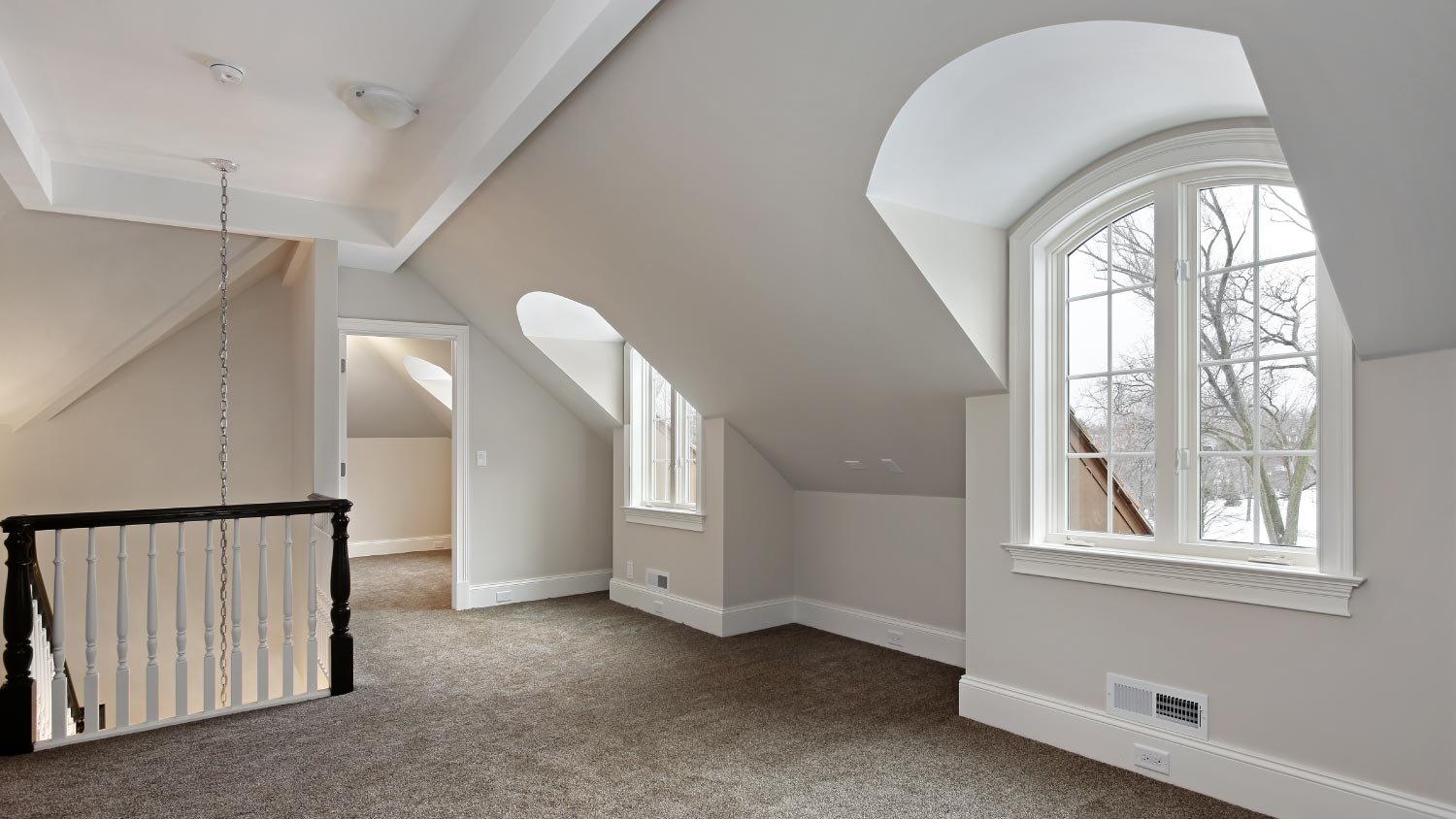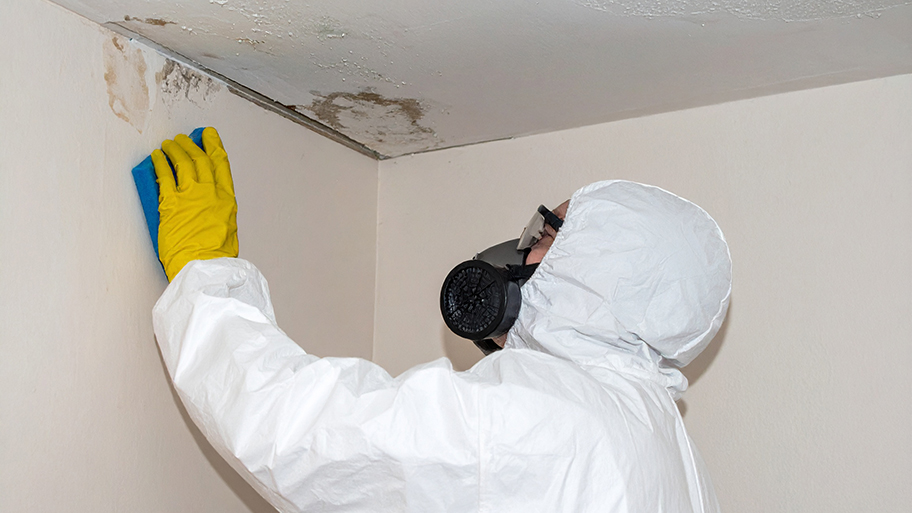
The cost of a mold inspection might seem high, but it’s one of the best investments you can make for your health and home. Read on to learn cost-saving tips.
A bold strategy to get rid of the most dreaded houseguest


Water is a soothing element, which is why the sound of ocean waves is so relaxing. Too much water in your home, however, can be a harbinger of mold—and stress. After a pipe bursts or a natural disaster like a hurricane occurs, a buildup of water in your home can lead to mold and mildew. If you’ve experienced water damage, run (don’t walk—mold grows quickly!) to read our tips before mold makes itself comfortable in your home.
Before trying to tackle mold removal on your own, keep DIY mold removal dangers in mind. Improper removal of mold can lead to thousands of dollars in repairs and mold remediation down the line, so you may be better off leaving this job to the pros.
As we’ve already mentioned (but it bears repeating!) the biggest risk factor for mold is moisture. So if you’re dealing with a leak or water damage of any kind, not only should you work to stop that issue, you should also be taking quick precautions to avoid mold growth.
Mold and mildew can develop within 24 to 48 hours after water exposure, so act immediately to clean things up and get your house back to its dry state. The sooner you spring into action, the more you can contain potential mold growth and avoid the associated health risks.
In the hours and days that follow water leaks, look out for discoloration, fuzzy growths and musty smells—all icky tell-tale signs of mold growth.
Before you go on mold patrol, take the following steps to stop it from happening in the first place.
Find the source of the leak flooding your home or other potential causes of unwanted water. Remember, water conducts electricity and floodwaters may contain bacteria, so coming into contact with it could be dangerous. When a pipe has burst, turn off the main valve if it is safe to do so, and call a local emergency plumber.
Rent a wet-dry vacuum to remove standing water in your home if the area is smaller than 10 square feet and there is less than an inch of water. Protect yourself with the right gear before coming into contact with contaminated water. Thrown on some safety glasses, gloves, boots, long sleeves, long pants, and a mask (like an N-95 respirator). If the standing water consumes an area larger than 10 square feet or there’s more than an inch of water, call a water damage restoration company in your area for help.
Check outside your home as well for groundwater or water collecting against your foundation. Water can seep into your home and lead to mold growth.
Remove, dry out, and clean damp items, and store them outside until your insurance can review the damage. Otherwise, these items can stay moist and possibly harbor mold. Look for porous items that may have gotten wet, including carpeting, rugs, wallpaper, drywall, ceiling tiles, insulation, clothing, paper, wood (including furniture), and food.
Some building materials like drywall, ceiling tiles, wallpaper, insulation, and carpeting will have to be replaced, or you run the risk of mold growing in and behind them and spreading. In addition, removing wet items will help reduce the overall humidity in your home, which can cause mold and mildew. The cost to rip up carpet and install laminate flooring averages between $1,590 and $4,690.
If you know how to check for mold and already notice some mold growing, stop it dead in its tracks. If you’re dealing with a smaller area, such as 10 square feet or less, you can choose to clean it yourself.
Sanitize hard surfaces, such as baseboards and walls, with a cleaning solution made of 1.5 cups of fresh chlorine bleach to one gallon of water. Wear protective gear—such as a face mask and rubber gloves—while cleaning with this solution.
Spray a solution of 10% fresh bleach to 90 percent water on any visible mold.
Let the solution sit for 10 minutes.
Rinse and allow the area to dry.
For soft surfaces, try an antimicrobial cleaner or undiluted white vinegar.
While you’re waiting for the right home flooding repair pro to show, air out your home. Open all windows and doors, set up several fans (aimed towards windows and doorways) to send humid air out, and run dehumidifiers for at least a few days. Look for a humidifier with a larger tank that will collect 60 or more pints of water per day, so you won’t have to empty it as often. Be on the lookout for musty smells that are indicative of mold.
Mold loves the moist, humid environment of bathrooms, and the right fan will help you control the humidity levels. Your bathroom fan should clear the room of moisture after five to 10 minutes. If it takes longer than this, you probably need a bigger fan.
CFM, or cubic feet per minute, measures how much air a fan moves. To find the appropriate CFM for your bathroom, multiply the square footage of the room by 1.1. If this number is larger than the CFM listed on your fan (usually labeled under the grille), replace it with a larger model.

Mold can hide in air ducts, behind walls, and underneath carpeting. If you think your HVAC system has been affected, don’t turn it on. Call a pro to inspect and clean your unit. If water damage or a mold problem feels out of control, it’s best to hire a certified mold removal provider near you to evaluate the situation and quickly get things back to a normal, drier state.
If you want to kick your mold prevention up a notch, take these additional precautions.
As a preventative measure, install humidity sensors in your home that will alert you if humidity levels are too high or too low. You can also purchase bath fans with humidity sensors; these smart fans will turn on when the moisture is high and turn off when it drops to normal levels, so you don’t have to worry about remembering to leave the fan on each time you take a shower.
In rooms with high moisture and humidity, such as the kitchen and the bathroom, opt to use paint that contains mildewcide on your walls. Many paint manufacturers already include mildewcide in their formulas, but check to be sure.
To prevent future mishaps, shut off the main water valve (and drain your pipes if you expect temperatures to drop below freezing) when you go on vacation. You can also install “no-burst” hoses on your washing machine, faucets, and toilets.
According to data from Angi customers, 47.5% of homeowners request immediate assistance with mold removal, and 24.4% indicate the timing is flexible. Mold removal isn’t an emergency if it’s in a small area and no one in your home is experiencing any mold-related symptoms.
However, if the mold is widespread, someone in the home is experiencing severe allergy-type symptoms with no other explanation, or you have at-risk people in the house, you should request mold removal as soon as possible.
From average costs to expert advice, get all the answers you need to get your job done.

The cost of a mold inspection might seem high, but it’s one of the best investments you can make for your health and home. Read on to learn cost-saving tips.

Mold remediation cost can quickly escalate. But if you have mold in your home, the cost for mold remediation is worth it.

If you have mold, the odds are you also have mold mites. Here's what you need to know about getting rid of and preventing these diminutive pests.

What causes mold? Excessive moisture in your home is likely to blame. Read on to learn more about what causes mold and how to prevent it.

Mold can enter your air ducts and lead to poor indoor air quality. Use this guide to learn how to get rid of mold in air ducts for healthier air.

Tired of an unmistakable odor permeating your living space? Learn how to get rid of a mold smell in your house, and reclaim a clean and odor-free home.